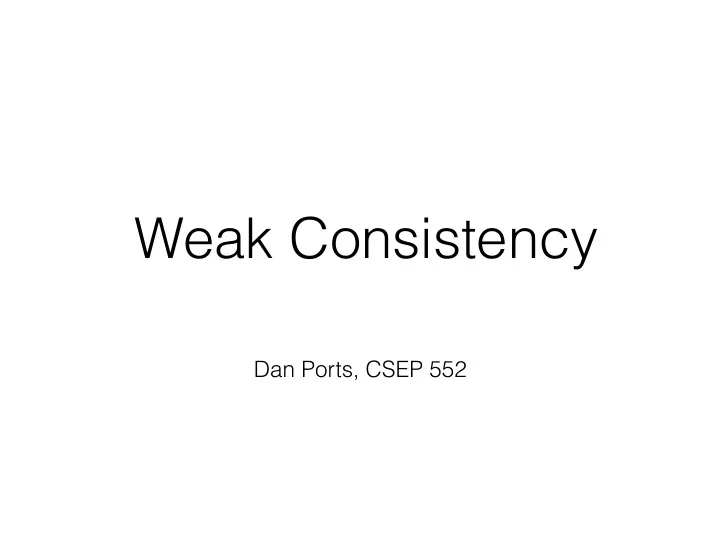

Weak Consistency Dan Ports, CSEP 552
CAP Theorem • Can’t have all three of consistency, availability, and tolerance to partitions • (but the devil is in the details!)
CAP • Eric Brewer, 2000: conjecture on reliable distributed systems • Gilbert & Lynch 2002: proved (for certain values of “consistency” and “availability”) • really influential and really controversial • motivated the consistency model in many NoSQL systems • Stonebraker: “encourages engineers to make awful decisions” • usually misinterpreted!
Usual Formulation • Choose any two of: consistency, availability, partition tolerance • Then: want availability, so need to give up on consistency • Or maybe: want consistency, so availability must suffer • Implies 3 possibilities: CA, AP, CP
First problem: type error • Consistency and availability are properties of the system • Partition tolerance is an assumption about the environment • What does it mean to (not) choose partition tolerance? • i.e., what does it mean to have a CA system? • Better phrasing: when the network is partitioned, do we give up on consistency or availability?
Other problems • What does (not) choosing consistency mean? What about weak consistency levels? • What does not providing availability mean? Does that mean the system is always down? • What if network partitions are rare? What happens the rest of the time?
A more precise formulation • (from Gilbert & Lynch’s proof) • model: a set of processes connected by a network subject to communication failures • meaning messages may be delayed or lost • it is impossible to implement a non-trivial linearizable service • that guarantees a response to any request from any process
Proving this statement • Not too surprising • Suppose there are two nodes, A and B and they can’t communicate • first: write(x) on A • then: read(x) on B • availability says B’s request needs to succeed, linearizability says it needs to return A’s value
How does this relate to FLP? • CAP: when messages can be delayed or lost in the network, can’t have both consistency and availability • FLP: when one node can fail and the network is asynchronous, can’t reliably solve consensus • FLP is a stronger (i.e., more surprising) result • CAP allows network partitions / packets lost entirely • CAP: every node to remain available FLP: failed nodes don’t need to come to consensus
Examples • Where do systems we’ve seen before fall in? Are they consistent? Available? Lab 2 • Paxos • Chubby • Spanner • Dynamo •
Paxos availability • Wasn’t Paxos designed to provide high availability and fault tolerance? • Remains available as long as a majority is up and can communicate • not availability in the CAP theorem sense! would require any node to be able to participate even when partitioned! • Is this enough?
Do partitions matter? • Stonebraker: "it doesn’t much matter what you do when confronted with network partitions" because they’re so rare • Do you agree?
Do partitions matter? • OK, but they should still be rare • When the system is not partitioned, can we have both consistency and availability? • As far as the CAP theorem is concerned, yes! • In practice? • systems that give up availability usually only fail when there’s a partition • systems that give up consistency usually do so all the time. Why?
Another “P”: Performance • providing strong consistency means coordinating across replicas • means that some requests must wait for a cross- replica round trip to finish • weak consistency can have higher performance • write locally, propagate changes to other replicas in background
CAP implications • Need to give up on consistency when • always want the system to be online • need to support disconnected operation • need faster replies than majority RTT • But can have consistency and availability together when a majority of nodes can communicate • and can redirect clients to that majority
Dynamo and COPS • What kind of consistency can we provide if we want a system with • high availability • low latency • partition tolerance
Dynamo • What consistency level does Dynamo provide? • How do inconsistencies arise? • Sloppy quorums: read at quorum of N nodes • …but might not be a majority • …but might not always be the same N nodes (just take healthy ones)
COPS • Guarantees causal consistency instead of eventual (or no) consistency • recall Facebook example: remove friend, post message • if get returns result of update X, also reflects all updates that causally preceed X • but causally concurrent updates can proceed in any other • “Causal+”: conflicts will eventually converge at all replicas
COPS Implementation • Multiple sites, each with full copy of the data • partitioned and replicated w/ chain replication • Writes return to client after updating local site • then updates propagated asynchronously to others • Lamport clocks and dependency lists in update message — ensures they’re applied in order
Next week • Co-Designing Distributed Systems and the Network: Speculative Paxos and NOPaxos (Adriana Szekeres) • MetaSync: File Synchronization Across Multiple Untrusted Sources (Haichen Shen) • Verdi: A Framework for Implementing and Formally Verifying Distributed Systems (James Wilcox and Doug Woos) • Tales of the Tail: Hardware, OS, and Application-level Sources of Tail Latency (Naveen Kr. Sharma)
Recommend
More recommend